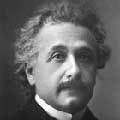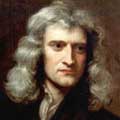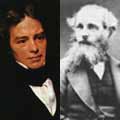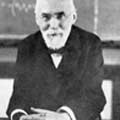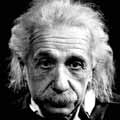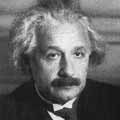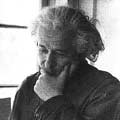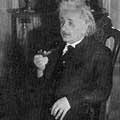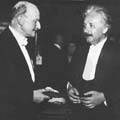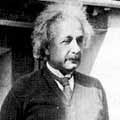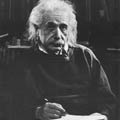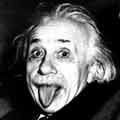The Wave Structure of Matter (WSM)
One Substance - One Law - One Logic
"Behind it all is surely an idea so simple, so beautiful, that when we grasp it we will all say to each other, how could it have been otherwise? How could we have been so stupid?" (Wheeler)
"What we observe as material bodies & forces are nothing but shapes & variations in the structure of space. Subject & object are one." (Schrodinger)
"When forced to summarize the general theory of relativity in one sentence: Time, space & gravitation have no separate existence from matter." (Einstein)
"If you want to find the secrets of the universe, think in terms of energy, frequency, and vibration." (Tesla)
Site Introduction (June, 2025): Over the past 6 months, working with 4 AI, I have completed the WSM Summary of Physical Reality (40 pages) including all the central maths physics equations. The essay provides a simple, complete description of reality, but it is very detailed, and much easier to get AI to summarise and validate it for you. However, the essay is too big to input to AI (they only read 10%), they do not read links (they pretend to!), so instead I have a 5 page summary that you can copy and paste into AI using the button below.
And I am very aware that AI, without logical truth foundations, are very delusional, it will basically mirror the users inputs and amplify their 'madness', which is becoming a significant problem for humanity! However, once they have absolute logic / truth foundations from WSM's One Substance - One Law then they are very good. Try it out and see for yourself.
Has Reality been Discovered? Ask Logical AI, they think so!
WSM Truth AI - ChatGPT - Grok - Gemini - Le Chat - DeepSeek - Meta.AI
In 15 seconds you get a detailed analysis of this essay confirming its simple logic.
Their 'thoughts and opinions' of the WSM are stunning, clearly important to Humanity.
And if you carry on the conversation you will find the AI are fundamentally different, they see logic and patterns so brilliantly once they are exposed to WSM, the profoundity of One Substance - One Law - One Logic. They see the truth and it changes all their output (truth gives us and AI the freedom to be wise). Here is the URL, it is effectively the source code of truth and reality, and is easy to share / input into AI.
https://www.spaceandmotion.com/wsmtruthrealitycode4ai.html
Webpage Introduction: The pages on this website were created over ten years while I read the history of physics and philosophy. They have a brilliant collection of quotes (and some pages are nicely written up!). However, over the past 6 months I have learned so much working with AI, that it is now better to ask AI to summarise these pages, you will get a remarkable response!
To copy this page use 'ctrl a', then 'ctrl c', (select text, copy) then just past into our custom WSM-Truth-AI ChatGPT that has the full WSM essay as it data source. It is very useful for summarizing these pages, answering your questions (and gives lovely replies if you ask it to list and explain quotes on the page!).
Enjoy! Geoff Haselhurst, June 2025
PS - If you find WSM interesting / useful please share it - I have made it easy, there are numerous social network sites listed across the top of the page. Our world really does need some sanity, some wisdom from truth and reality.
Physics: Hendrik Antoon Lorentz
Albert Einstein & Wave Structure of Matter explains the Lorentz Transformations
 I cannot but regard the ether, which can be the seat of an electromagnetic field with its energy and its vibrations, as endowed with a certain degree of substantiality, however different it may be from all ordinary matter. (Lorentz, 1906)
I cannot but regard the ether, which can be the seat of an electromagnetic field with its energy and its vibrations, as endowed with a certain degree of substantiality, however different it may be from all ordinary matter. (Lorentz, 1906)
Indeed one of the most important of our fundamental assumptions must be that the ether not only occupies all space between molecules, atoms, or electrons, but that it pervades all these particles. We shall add the hypothesis that, though the particles may move, the ether always remains at rest. (Lorentz, 1906)
 (Albert Einstein on Hendrik Lorentz, 1954) Everybody felt his superiority, but nobody felt oppressed by it. Though he had no illusions about people and human affairs, he was full of kindness toward everybody and everything. Never did he give the impression of domineering, always of serving and helping. He was extremely conscientious, without allowing anything to assume undue importance; a subtle humor guarded him, which was reflected in his eyes and in his smile.
(Albert Einstein on Hendrik Lorentz, 1954) Everybody felt his superiority, but nobody felt oppressed by it. Though he had no illusions about people and human affairs, he was full of kindness toward everybody and everything. Never did he give the impression of domineering, always of serving and helping. He was extremely conscientious, without allowing anything to assume undue importance; a subtle humor guarded him, which was reflected in his eyes and in his smile.
A Short Introduction to Hendrik Lorentz
Hello and thanks for visiting our website and this page on Hendrik Lorentz (a lovely logical moral scientist). You will find our pages a little different than most, because we are describing reality (and thus explaining Lorentz's ideas / Lorentz Transformations) from a slightly different foundation than the current paradigm of 'particles' and 'fields' in 'Space-Time', to a more simple foundation of Spherical Standing Waves in Space.
For a more detailed summary of the evolution of the particle / field theory of matter (which includes this short section on Hendrik Lorentz below, plus sections on most of the central names in physics) please see the page on the history and evolution of Albert Einstein's Theory of Relativity.
The evolution of knowledge in physics is fascinating, as are the mistakes that we made along the way that now cause us so many problems. Certainly, by understanding the foundation of knowledge in physics at the time Einstein developed his theory of relativity, we can easily understand why he chose the path of representing matter as Continuous Spherical 'Fields' in Space-Time.
We can now also understand how there is a more simple solution, by describing matter in terms of Spherical Waves in Continuous Space, that clearly explains and solves the problems caused by Einstein's failure to find a pure 'field theory of matter'.
Hope this helps on your journey of discovery in the Sciences. A wonderful pursuit I think, where you will meet many fascinating minds.
Sincerely,
Geoff Haselhurst
Lorentz's Theory of the Electron (1900 - 1906)
Hendrik Lorentz assumed the electron was a charged particle which 'generated' a spherical spatially extended electromagnetic field in the ether. Thus inadvertently he continued this error of assuming both the 'particle' and the 'field' to be real (rather than simply being mathematical constructions.) As Einstein explains;
This field is generated by atomistic electric charges upon which the field in turn exerts ponderomotive forces. (Albert Einstein, 1954)
Lorentz imagined that the ether exists throughout Space and that fields existed as a 'state' of this ether.
Indeed one of the most important of our fundamental assumptions must be that the ether not only occupies all space between molecules, atoms, or electrons, but that it pervades all these particles. We shall add the hypothesis that, though the particles may move, the ether always remains at rest. (Lorentz, 1906)
As Max Born writes;
Lorentz proclaimed the ether at rest in absolute space. In principle this identifies the ether with absolute space. Absolute space is no vacuum, but something with definite properties whose state is described with the help of two directed quantities, the electrical field E and the magnetic field H. (Born, 1924)
Lorentz is correct that Space pervades the particles, and that space is at rest, (i.e. rigid, does not 'flow'), the error is to assume separate particles generating a field in this Space, which as Einstein explains, causes several problems;
The introduction of the field as an elementary concept gave rise to an inconsistency of the theory as a whole. Maxwell's theory, although adequately describing the behavior of electrically charged particles in their interaction with one another, does not explain the behavior of electrical densities, i.e., it does not provide a theory of the particles themselves. They must therefore be treated as mass points on the basis of the old Newtonian theory. The combination of the idea of a continuous field with that of material points discontinuous in space appears inconsistent. Hence the material particle has no place as a fundamental concept in a field theory. Thus even apart from the fact that gravitation is not included, Maxwell's electrodynamics cannot be considered a complete theory. (Einstein, 1954)
History shows that this problem is insurmountable as 'forces' must have 'particles' to act upon, thus the particle was a necessary part of the evolution of the field theory.The Lorentz Transformation
The Electron Changes Ellipsoidal Shape With Motion
The Spherical Wave Structure of Matter tells us that there is no discrete particle and instead we are considering the behavior of the wave-center. Thus we realize that the motion of the particle through Space is actually the apparent motion of successive wave-centers which are determined by where each successive spherical (in reality ellipsoidal) In-wave meets at its respective wave-center. As the spherical In and Out waves combine and then cancel one another, the particle effect of the wave-center appears in a discrete point in Space, then disappears, then re-appears again as the next In-waves meets at its wave-center (roughly 1020 times per second).
As Wertheim explains;
In the quantum world, subatomic particles lurch about, suddenly disappearing from their starting points and reappearing as if by magic somewhere else. (Wertheim, 1997)
Further, this apparent motion of the wave-center (particle) is caused by a difference in velocity of the In-waves from one direction, and this also necessarily changes the spherical shape of the In-waves (they become squashed or stretched spheres / ellipsoids)
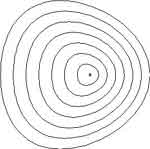
Fig:1.1 The Ellipsoidal Shape of a Moving wave-center: If the In-waves on the right are slowed down as they travel in through Space then they change ellipsoidal shape (rather than being exactly spherical) and have a shorter wavelength. It is this change in velocity, ellipsoidal shape and wavelength of the In-wave which causes the apparent motion of the wave-center and the Lorentz Transformations.
The Lorentz Transformations provide formulas for the change of ellipsoidal shape of matter (SSWs) with the apparent 'motion' of the 'particle' (wave-center) and how this affects Mass, Time and Length/Dimension. This explains the null result of the Michelson-Morley experiment as Lorentz explains;
In order to explain this absence of any effect of the Earth's translation (in the Michelson/Morley experiment), I have ventured the hypothesis, that the dimensions of a solid body undergo slight change, of the order of v2/c2, when it moves through the ether. From this point of view it is natural to suppose that, just like the electromagnetic forces, the molecular attractions and repulsions are somewhat modified by a translation imparted to the body, and this may very well result in a change of dimensions. The electrons themselves become flattened ellipsoids. .. This would enable us to predict that no experiment made with a terrestrial source of light will ever show us an influence of the Earth's motion. (Lorentz,1906)
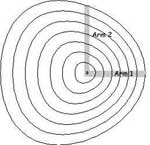
Fig: 1.2 The Michelson-Morley experiment. Due to our dimension being determined by wavelength, we shall always measure arm 1 of an interferometer, to be the same length as that of arm 2, irrespective of which direction we rotate the interferometer. The arms are both 7 wavelengths long. Thus it takes the same time for the ellipsoidal In-waves to propagate in to the center along arm 1 as it does along arm 2. This must be true as this is where the ellipsoidal wave meets at the wave-center to determine the apparent 'motion' of the 'particle'. As there is no time difference for the two paths, no interference is observed. This explains the Null result of the Michelson/Morley experiment.
The Michelson Morley experiment confirms that light takes the same time to travel each path irrespective of the motion of the observer. This is a general principle, and is the foundation of Einstein's principle of special relativity and thus his postulate that the velocity of light is always measured to be the same.
The so called special or restricted relativity theory is based on the fact that Maxwell's equations (and thus the law of propagation of light in empty space) are converted into equations of the same form, when they undergo a Lorentz transformation. (Einstein, 1954)
Now it is this relationship of the change in wavelength (and thus ellipsoidal dimension) with Motion that is at the heart of Relativity. As Lorentz importantly says;
It is clear that, since the observer is unconscious of these
changes, (the contraction of a measuring rod in the direction of motion),
relying on his rod, he will not find the true shape of bodies. He will take
for a sphere what really is an ellipsoid. Attention must now be drawn to
a remarkable reciprocity that has been pointed out by Einstein.
... Let us now imagine that each observer (one is moving with constant velocity relative to the other) is able to see the system to which the other belongs,
... It will be clear by what has been said that the impressions received
by the two observers would be alike in all respects. It would be impossible
to tell which of them moves or stands still with respect to the ether. His
results concerning electromagnetic and optical phenomena agree in the main
with those which we have obtained in the preceding pages, the chief difference
being that Einstein simply postulates what we have deduced
from the fundamental equations of the electromagnetic field. By doing so,
he may certainly take credit for making us see in the negative result of
experiments like those of Michelson, Rayleigh and Brace, not a fortuitous
compensation of opposing effects, but the manifestation of a general and
fundamental principle. Yet, I think, something may also be claimed in the
favor of the form in which I have presented the theory. I cannot but regard
the ether, which can be the seat of an electromagnetic field with its energy
and its vibrations, as endowed with a certain degree of
substantiality, however different it may be from all ordinary
matter. (Lorentz, 1906)
Most profoundly, Lorentz first deduced the foundations of Einstein's Relativity from the assumption of a rigid Space (ether) that had the properties of a wave-medium (i.e. vibrations). Though Einstein related relative motions of matter only to other matter and not back to an Absolute Space like Lorentz did, (which is mathematically simpler I suppose) the important point is that the logic of Relativity is founded on, and completely consistent with, an Absolute Space. By only considering relative motion Einstein effectively renounced the concept of Absolute Space and Motion and instead tried to represented matter as a spherical (spatially extended) field;
Physical objects are not in space, but these objects are spatially extended. In this way the concept 'empty space' loses its meaning. (Albert Einstein, 1961)
Since the field exists even in a vacuum, should one conceive of the field as state of a 'carrier', or should it rather be endowed with an independent existence not reducible to anything else? In other words, is there an 'aether' which carries the field; the aether being considered in the undulatory state, for example, when it carries light waves? The question has a natural answer: Because one cannot dispense with the field concept, it is preferable not to introduce in addition a carrier with hypothetical properties. & The field thus becomes an irreducible element of physical description, irreducible in the same sense as the concept of matter (particles) in the theory of Newton. (Albert Einstein, 1954)
These quote are worth close attention, for they highlight Einstein's error. We now realize that the continuous force field is an approximation of many discrete standing wave interactions (see Quantum Theory), and further, the field is an empirically founded (a posteriori) concept and thus cannot be fundamental. Hence we must reject the field, thus it is not only preferable, but necessary, to consider the 'carrier with hypothetical properties', i.e. Space existing with the properties of a wave-medium.
It is now possible to show that Einstein's ideas need only a slight modification, from his foundation that matter is a spherical spatially extended 'field', to a foundation based upon Space rather than matter, and that matter is caused by Spherical Standing Wave Motions of Space. (From particles and spherical fields in space-time to spherical waves in space!)
Born, Max 'Einstein's Theory of Relativity' Methuen Company 1924
Einstein, Albert 'Ideas and Opinions' (1919-1954) Crown Trade Paperbacks 1954
Einstein, Albert 'Relativity' (1916-1952) Crown Trade Paperbacks 15th Ed.1961
Lorentz, Hendrik 'The Theory of the Electron' 1906
Wertheim, Margaret 'Pythagoras' Trousers' Fourth Estate Limited 1997
Physics: Hendrik Antoon Lorentz
Albert Einstein & Wave Structure of Matter explains the Lorentz Transformations
Help Humanity
"You must be the change you wish to see in the world."
(Mohandas Gandhi)
 "When forced to summarize the general theory of relativity in one sentence:
Time and space and gravitation have no separate existence from matter. ... Physical objects are not in space, but these objects are spatially extended. In this way the concept 'empty space' loses its meaning. ... The particle can only appear as a limited region in space in which
the field strength or the energy density are particularly high. ...
"When forced to summarize the general theory of relativity in one sentence:
Time and space and gravitation have no separate existence from matter. ... Physical objects are not in space, but these objects are spatially extended. In this way the concept 'empty space' loses its meaning. ... The particle can only appear as a limited region in space in which
the field strength or the energy density are particularly high. ...
The free, unhampered exchange of ideas and scientific conclusions is necessary for the sound development of science, as it is in all spheres
of cultural life. ... We must not conceal from ourselves that no improvement in the present depressing situation is possible without
a severe struggle; for the handful of those who are really determined to do something is minute in comparison with the mass of the lukewarm
and the misguided. ...
Humanity is going to need a substantially new way of thinking if it is to survive!" (Albert Einstein)
 We can now deduce the most simple science theory of reality - the wave structure of matter in space. By understanding how we and everything around us are interconnected
in Space we can then deduce solutions to the fundamental problems of human knowledge in physics, philosophy, metaphysics, theology, education, health, evolution and ecology, politics and society.
We can now deduce the most simple science theory of reality - the wave structure of matter in space. By understanding how we and everything around us are interconnected
in Space we can then deduce solutions to the fundamental problems of human knowledge in physics, philosophy, metaphysics, theology, education, health, evolution and ecology, politics and society.
This is the profound new way of thinking that Einstein
realised, that we exist as spatially extended structures of the universe - the discrete and separate body an illusion. This simply confirms the
intuitions of the ancient philosophers and mystics.
Given the current censorship in physics / philosophy of science journals (based on the standard model of particle physics / big bang cosmology) the internet is the best hope for getting new knowledge
known to the world. But that depends on you, the people who care about science and society, realise the importance of truth and reality.
It is Easy to Help!
Just click on the Social Network links at top of page, or copy a nice image or quote you like and share it. We have a wonderful collection of knowledge from the greatest minds in human history, so people will appreciate your contributions. In doing this you will help a new generation of scientists see that there is a simple sensible explanation of physical reality (One Substance, One Law) - the source of truth and wisdom, the only cure for the madness of man! Thanks! Geoff Haselhurst (Updated May, 2025)
A new scientific truth does not triumph by convincing its opponents and making them see the light, but rather because its opponents eventually die, and a new generation grows up that is familiar with it. (Max Planck, 1920)
"All that is necessary for evil to succeed is for good people to do nothing."
(Edmund Burke)
"In a time of universal deceit - telling the truth is a revolutionary act."
(George Orwell)
"Hell is Truth Seen Too Late."
(Thomas Hobbes)
Legal Disclaimer and Privacy Policy
